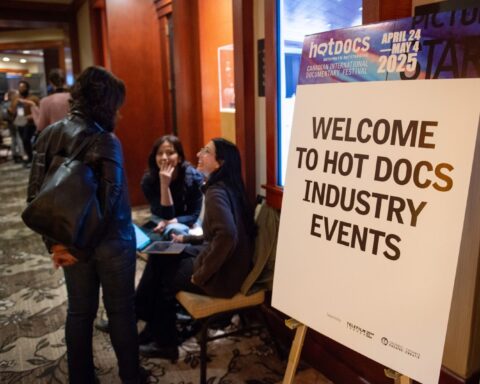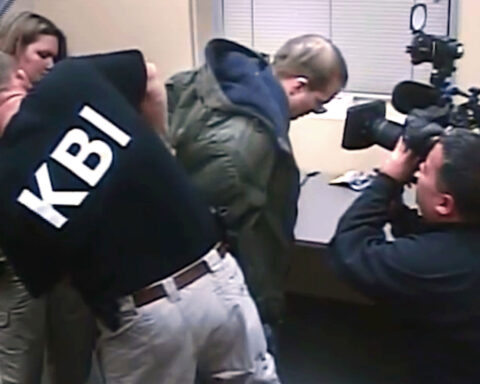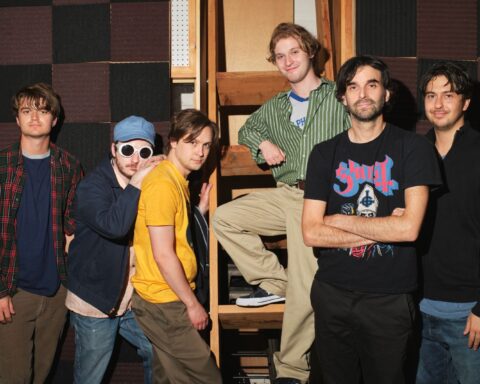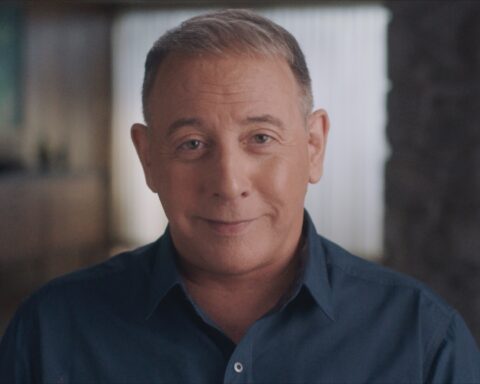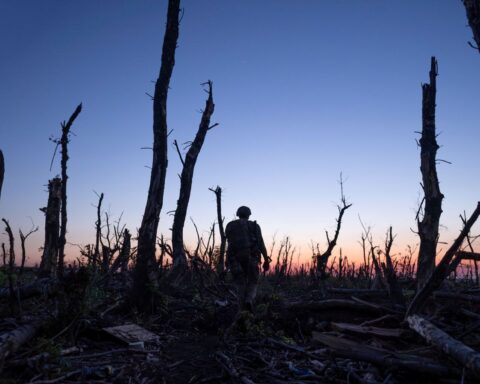Samir picked up his wife’s hand and told her he’d been thinking long and hard about their 10-year marriage. I glanced over to monitor two—a good close-up of Veena looking both anxious and hopeful. This was their anniversary dinner, after all, and she was expecting heartfelt sentiments and, at least, a bunch of red roses. We all paused, holding our breath, waiting for Samir to tell Veena how much she meant to him. Then suddenly he faltered, dropped her hand and looked searchingly across the hotel room full of camera ops and sound booms for the director.
“I forgot what I had to say.”
The director in question, frustrated and tired like the rest of us on take 13 of the final scene of the episode, reminded him that he only had to say what he felt, that he didn’t have a line, but Samir didn’t want to waste time being honest or thoughtful, he wanted to say whatever we wanted him to say. It was nearly midnight and the crew was about to revolt. I pulled out my earpiece and walked over to him. “Tell her you love her.” The camera flipped back on, Samir told Veena he loved her and we called it a wrap. I fell back on the bed and stared up at the ceiling and thought to myself: this is hell, get me out of here.
Actually, it wasn’t hell, it was a lifestyle show—one of my own co-creations that I produced with my partner in crime, Jeannette Loakman, at Chocolate Box Entertainment. In the show, we took boorish, unromantic slobs and turned them into suave gentlemen for their wedding or anniversary. It was typical makeover fare and required just two things—a real person and a happy ending. How we turned those two things into good ratings was less simple and involved a complex dance of mutual exploitation. We needed to mine the maximum amount of drama out of their lives in the shortest possible time and they wanted a free suit and to get famous. After a week of trying to teach Samir table manners and getting him in touch with his “inner feelings,” we found our subject had made no romantic progress whatsoever but he had become a sly collaborator in the process of producing reality TV. Just what poor Veena thought of it all I shuddered to think.
That was 2006. Since then I haven’t made another reality show, but I am making docs, and I keep asking myself if they are really that much different. Yeah, of course, it’s hard to compare the cinematic genius of Last Train Home to Canada’s! Worst! Driver! I’m not talking about that. I’m talking about how documentary filmmakers are also purveyors of a tell-all, show-all, know-all culture, the same culture where if you haven’t been on TV or in a YouTube video or at least been “liked” on somebody’s Facebook page, then you don’t exist. Everyday life has become pop-culture entertainment, as equally exploited by big TV networks and social-media companies as it is by the Jacks and Jills who offer up their lives in exchange for being noticed.
That makes me, your typical liberal who wants to make a difference with my art-documentaries, a bit queasy. What is happening when I take the raw ingredients of life and turn them into an entertaining product? And is that end product an approximation of reality, a blatant exploitation of it or a mushy in-between that is blurring the lines of fact and fiction?
Three years after producing a reality-TV show, I found myself taking a shower with Hal Niedzviecki. Hal is the author of The Peep Diaries: how we’re learning to love watching ourselves and our neighbours. He is also a particularly hirsute individual, as I was discovering that afternoon. (I mean, really, this guy’s back hair is phenomenal. Check it out if you don’t believe me.) Hal is the guy who invented the phrase ‘peep culture’ to talk about how today’s society encourages voyeurism as mass entertainment and his thesis struck a chord. Why did Samir and all those other men offer their personal lives up so easily to be broadcast and exploited? What did they—and the viewers—get out of the exchange?
To answer this question, Jeannette and I decided to make our next film about Hal and his ideas. This was the first day of shooting, and so far I had filmed him pretending to take out the garbage, trim his tree and make breakfast for his three-year-old daughter. Now the crew and I were crammed into his bathroom filming him pretending to take a shower. Why all this pretending? Wasn’t this a documentary?
I know as well as anyone that the best moments are the real moments, ones that haven’t been set up or redone. But in a world of tight schedules and limited budgets, real people are more often than not getting turned into underpaid actors. A friend of mine is a well-respected lifestyle director, and he told me that before every episode, he gathers together the family/couple and says, “This is your story and we’ll write it together.” The characters are actively encouraged to come up with their own storylines and brainstorm ways to make the show more dramatic and fun.
That’s reality TV, not documentary, I can hear you say. Well, our motives as doc-makers might be different but our means are often similar.
Look at one of the genre’s greats: Werner Herzog. In his film Little Dieter Needs to Fly, the subject, Dieter, escaped from a Cambodian prison camp. He had been treated abysmally. After he was free, he went to live on a mountaintop in California. In the film, we see Dieter entering his house and having to open and close the door obsessively from both sides, over and over again, to make absolutely certain that he isn’t locked in. We realize that it’s something he does every time he goes home. But as it turns out Dieter didn’t normally do this at all. It was 100 percent Herzog’s creation.
Director Barry Stevens brought this story up to me as an example of a director who bends the rules of reality just a bit too far. “A filmmaker has a contract with the audience. The difference between documentary and fiction is not whether there are reconstructions, etc. The difference is that the filmmaker is implicitly promising two different things to the audience. In the case of documentary, he is promising that what he is presenting has a close relationship to generally agreed-upon reality. It may be his interpretation of reality, it may be his re-ordering and manipulation, but if he directly says that, say, Paris is the capital of Russia, he has violated that contract.”
When Herzog was told of Stevens’ criticism he apparently replied: “If you want facts, read the Manhattan phone book.”
We all know that filmmaking by its very nature has to bend the facts. I often think back to something Steven Silver said to me when we were in the edit room piecing together a film he had directed. I was just a neophyte producer at that time and when I saw him borrowing bits and pieces of footage and using them in unrelated scenes, I asked him what he was doing.
“Lying the truth,” he responded with a dramatic flourish of the paste key. In other words, there is a greater truth to which you must remain loyal, but the means by which you express this truth are a bit looser.
The debate over a documentary’s “creative use of actuality,” as Grierson put it, is one we’ve hashed out many times as documentarians, but now I think it’s only half of the question. The other half is: Whose actuality is it to begin with? What’s happening on the other end of the lens?
I’m part of a documentary community, which has been capturing people’s lives on film for over a hundred years. Not too surprisingly, our subjects have picked up a few tricks of the trade in that time. Questioning what is “real” and what is not real seems positively old school; certainly most of the subjects we film don’t seem all that concerned. Look at Dieter—it’s not like Herzog forced him to open and close the door. He was a co-author of the invention, happy to collaborate in the hopes that the film version of his life would be as gripping and popular as possible.
People are used to being on camera, whether it’s ours or their own, whether it gets shown on CBC or YouTube. Playing yourself is profitable, after all—just ask the people who participate in reality-TV shows in France. It’s now mandatory by law in that country to hire participants at €1,400 a day plus social charges and a 35-hour working week—just like any other salaried employee. Should they get overtime if they go home and edit their own sequences as well? “Lying the truth” isn’t just normal these days—it’s a career option.
So for filmmakers the goal posts have shifted. We don’t just worry about bending the truth of our subjects’ lives, we now have to wonder just how “truthful” are the lives we’re supposedly documenting. There are umpteen cases of outright fraud—the fake marriage betrayal on Moment of Truth and half the stories on Jerry Springer come to mind—and even this year’s bumper documentary crop produced a few head-scratchers like Exit Through the Gift Shop and Catfish. It’s not like we’ve turned into a planet of liars, but we do live in a media-saturated, celebrity-obsessed world where your personal story, as dramatic and embellished as possible, is a commodity you can buy and sell.
With so many cameras, so many outlets for personal expression, you start to wonder if we’re living our “actual” lives or subconsciously rearranging them to more closely resemble the opening 30-second round-up of Entertainment Tonight. As filmmakers we’re part of the mutual-exploitation vortex. We self-censor our stories to choose characters that “pop” on screen and edit their stories down for the maximum number of confessions/breakdowns/life-changing events per minute—then release them back out into the wild, subtly changing the real-life vs. dramatic-reconstruction equilibrium as we do so. And the cycle begins again.
“There are so many voices—so much media—that the individual has become marginalized. It’s very hard to stand out,” reality-TV producer Lincoln Hyatt tells me as I film an interview with him for Peep Culture. He and Andrew Calder produce a show called Solitary where participants get locked up in solitary cells for days at a time and are submitted to light-torture experiments like sleep and food deprivation. The prize money isn’t huge and you have a slim chance of winning, so why would anybody agree to go on their show?
“In the U.S., with Horatio Alger and the idea that anybody can rise above, it’s getting harder and harder to live our own myth,” says Hyatt. “But if you put yourself on a reality show you can stand up and be counted. You have a way of screaming your primal scream and saying ‘I exist’.”
That’s the exchange. We want to be noticed, we need to be noticed, so instead of fighting the media glut, we join it and try to win by playing its rules.
Which brings me back to Hal in the shower, or rather Hal in the kitchen, as we were now filming him cooking Indian in a pair of mismatching plaid shorts and shirt. An audience of 10 or so of his regular “viewers” joined in via his live feed on the Internet. We couldn’t see them but they were surprisingly present, making themselves known with every little computer ping. We had installed five surveillance cameras in Hal’s living room, kitchen, bathroom and office and hooked them up to our website via the popular amateur-video site Justin.tv. The point of it all was to find out if the process of sharing his life through a broadcast would find him friendship, recognition and happiness or turn him into a narcissist who couldn’t stop transmitting.
So far, it was a toss-up. In the first week almost 5,000 people had tuned in to watch Hal pee on the can-cam, but he hadn’t gained a single new ‘friend’. By the second or third week, he was chatting obsessively online while regular viewers watched him eat, sleep and read his email. None of this was gripping stuff. Most was excruciatingly, mind-numbingly dull, in fact—and yet they still watched, hungry for unmediated, unaltered, raw personal footage.
As a filmmaker, I get it. Now that our subjects are equal partners in the video testimonial of their lives, it’s tempting to try and escape the mutual-manipulation vortex by either eliminating them altogether (Radiant City) or installing remote-control cameras to tire them out (The Family). When I asked Steven Silver recently about “lying the truth,” he said he’d changed his mind, that today it’s much more powerful to let a piece of raw footage roll and narrate the exact details of what you are seeing over it.
But I’d guess that “raw” or “real” footage will also become an endangered species. We live for the audience now: real, imagined or anticipated. Raw! Live! Uncensored! footage is just another way to attract eyeballs.
We filmed over 3,000 hours of it for Peep Culture —weeks of Hal’s life—and all the time I prodded and poked, hoping to spark an emotional outburst that would play well for the camera. I wanted to know the “real” Hal (his juicy secrets) but he just wasn’t coughing up the goods. Months of monotonous filming went by—watch Hal read the paper, watch Hal get his daughter dressed for school, watch Hal take a nap—and it was all piling up into a heap of nothing. The online viewers were in agreement: “I don’t find this an interesting vlog so far! We want to know who YOU are.” As Jeannette and I pulled our hair out—maybe we can turn Hal into an animated character and get Seth Rogen to do the voice?—we were all missing the point.
We were really getting to know Hal. It was taking weeks, months even, but piece by piece, shared moment after shared moment, Hal’s life was slowly taking shape before the eyes of the viewing public. That’s how real life works, after all. But it happened so quietly we all assumed he was faking it.





